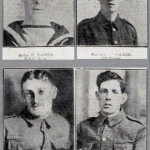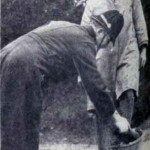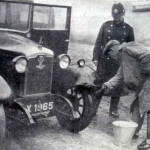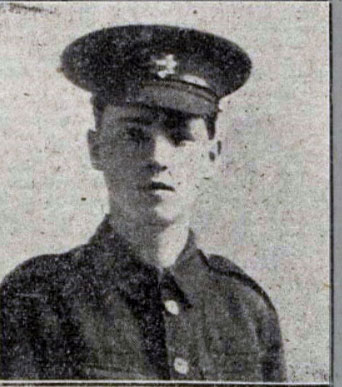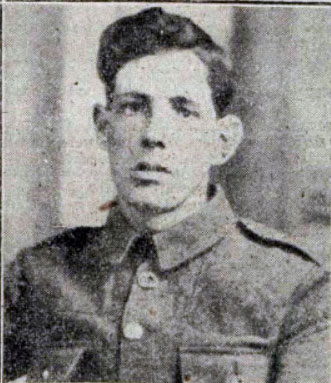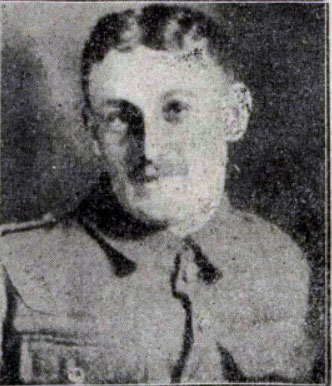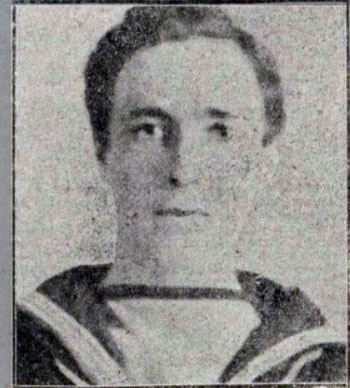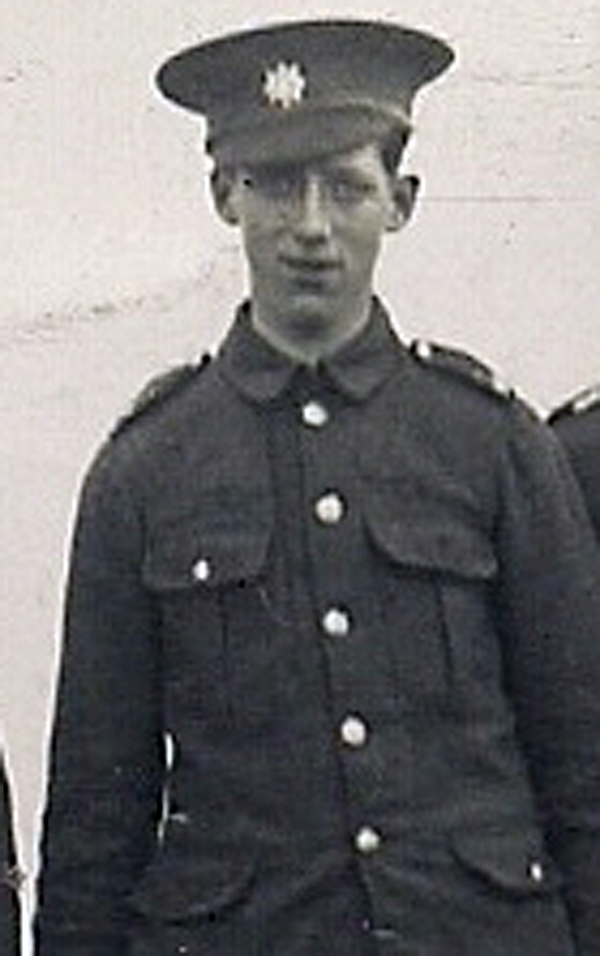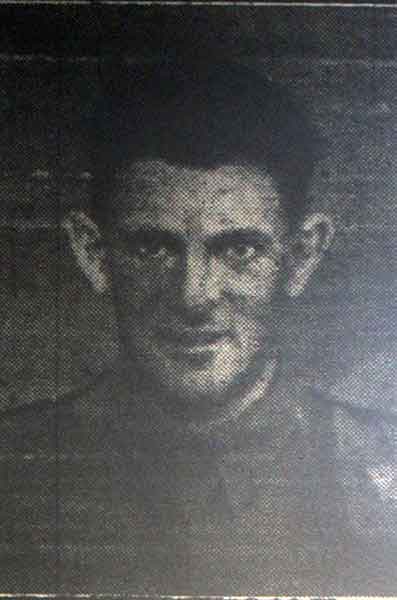.
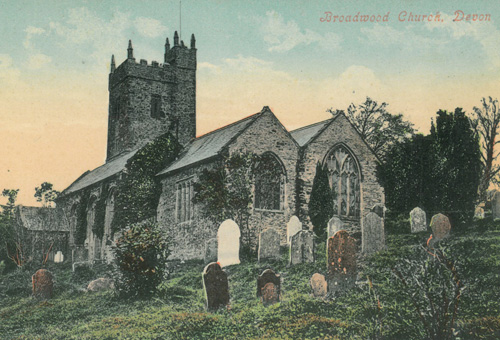
Broadwoodwidger is a village and civil parish in the Torridge district of Devon, England. The village is just to the north of the A30 road, and is about eight miles east of Launceston in Cornwall, and 13 miles west of Okehampton. The soil is loamy; subsoil, clay and slate. According to Risdon’s Survey of Devon (1714), ‘Sir John Widger, Knight, Lord of the Manor gave his name to the area’. Roadford Reservoir, which is also called Roadford Lake, is to the north-east of the village, and the River Wolf passes at the bottom of the hillside on which the village stands. Reportedly to be the second largest in Devon, Broadwoodwidger is made up of many Hamlets spread around the parish, as well as the Churchtown there is also Rixton, Kellacott and Upcott. Also known as Bradwood Widger. A parish in Lifton Hundred, the Archdeaconry of Totnes and the Diocese of Exeter. According to Peskett: “this parish was transferred during the period 1875 to ca 1919 to the deanery of Trigg Major and Archdeaconry of Cornwall.” Parish Registers going back to 1654 are held in the Devon Record Office.
A new 91 child capacity school was opened at Ivy House in July, 1880. Built of Halwill stone and granite dressings, covered with Delabole Slate and Bangor strings, the construction was carried out by Halwill builder Marwood White to a design by Launceston architect Charles Wise. Another Wise designed school was also opened at the same time at Thorn Cross, this school with a capacity to hold some 80 children. Built by Broadwood builders Squire and Hill, it was constructed of local stone with white brick dressings. Both these schools have now closed and the buildings have been converted for residential use.
According to the Church Notes by the Rev. Fulford Williams, the church dedicated to St. Nicholas dates from 1288 when it paid £13 parochial quota, the highest of any church in the Deanery of Tavistock. The font and chancel arch are thought to date from that period. In 1288 the Manor was owned in fief by the Wyger family and Sir John Wyger was patron of the church. He sold the Manor to Richard de Stapleton in 1319. In 1332 the Priory of Frithlestock was given the manor of Brodewodewyger by Thomas de Stapleton. The basic structure of the church is little changed from 1531 when the South Aisle was added and the arcade of granite columns and arches erected. As much as possible of the original woodwork was incorporated, which is evident in the bench ends, one of which bears the date 1529 the same date as the rood screen. Major restoration work was done in 1871 when the interior was completely refurbished and redecorated.
In 1965 the roof was found to have been severely damaged by death watch beetle and the church closed for a period while the whole roof was renewed in the old barrel-vaulted style. The re-dedication of the church took place on the 10th June 1966. Of the bells, the second, third, fifth and tenor are dated 1775, the fourth bell is dated 1872 and the treble 1904. In 1977 the six bells were taken to Whitechapel Foundry in London to be re-tuned and the fourth bell recast, when returned in 1978 they were installed on a steel frame. In 1997 the Upcott Arch was strengthened.
In the chancel are the tombstones of the Rev. Henry Newborough, 6 July 1725, and John Harmsworth, Supervisor of Excise, Winchester, 1 Jan. 1725 age 37. The church owns a beautiful silver flagon the gift of R. Secombe, 9 June 1794. He appears to have been Churchwarden in 1766. The 1744 visitation replies note that the parish is still in the Deanery of Tavistock, the minister is Rev. John Tindal Cur(ate) of Brentor, residing ‘upon the cure’, in receipt of ‘£33 per annum for serving this parish and Germans week which is one Cure’. There were 46 families which included between 30 and 40 communicants; no school, almshouse or any notable endowments.
The 1779 Visitation replies by ‘Thos. White, perpetual Curate of Broad wood widger and Jarmans Weike’ who lived in South Tawton in the Deanery of Exeter, which he served as minister. His salary had gone up to £35 per annum, and the number of families had risen to ‘about 100’, the communicants ‘may be about 30’. There was no school or almshouse and ‘I have no Terrier of the Glebe Lands and House this lies in the Chaple of Bristol.’ Endowed Charities mentions the will of Roger Harvey. The will bears the date 16 May 1763 and gave ‘certain fields in St. Giles in the Heath and other places the fees and rents to provide education for children of Broadwood and St. Giles. The Charity to be administered by the churchwardens’. This applied for a time, but the property was claimed and returned to the heir-in-law on the grounds of the gift being void under the Mortmain Act, 24 June 1824. At an enquiry 12 July 1911 William Harvey, a representative of the donor of the gift, and owner of the property gave £2 a year to poor funds as a voluntary gift. In 1877 the parish was transferred to Truro Diocese, in 1905 it was transferred to Exeter.
Outside of the church is an old Celtic cross found at Buddle supporting an out building and moved to its present location beneath the rare fern leaf beech in 1891. The beech tree bears both fern shaped (serrated) and normal beech leaves and is believed to be c 400 years old. Also close to the church is the site of the old ruined rectory which was given by the Ecclesiastical Commissioners for the use as a school room, when the school closed, this was and is used as the Church Hall.
Broadwoodwidger Oath-Takers, 1723
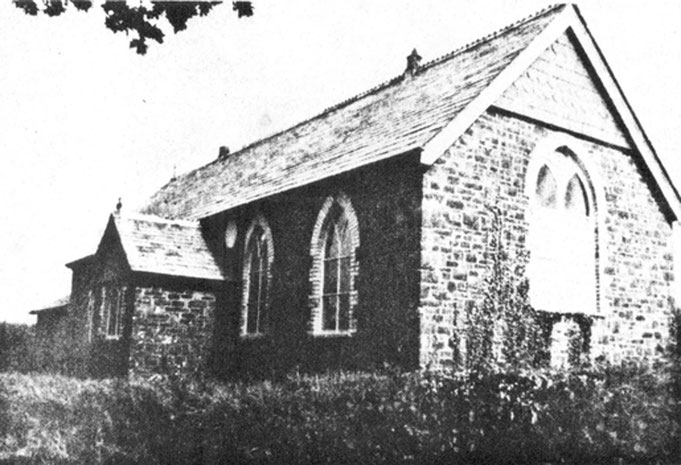
At Rexon Cross there is a chapel which dates back to 1860 and was built as a Bible Christian Church and Broadwoodwidger Chapel at Grinnacombe Moor which was built originally in 1844 and rebuilt in 1898. However in the nineteenth century other chapels were built in the Parish, Thorn Cross (above) was built in 1881 as a Baptist Chapel and Downicary Methodist Chapel was thought to have been built in the mid nineteenth century. Thorn Cross and Downicary are both now closed and on the 2nd December 2013 Rexon Cross also closed after 153 years of worship.
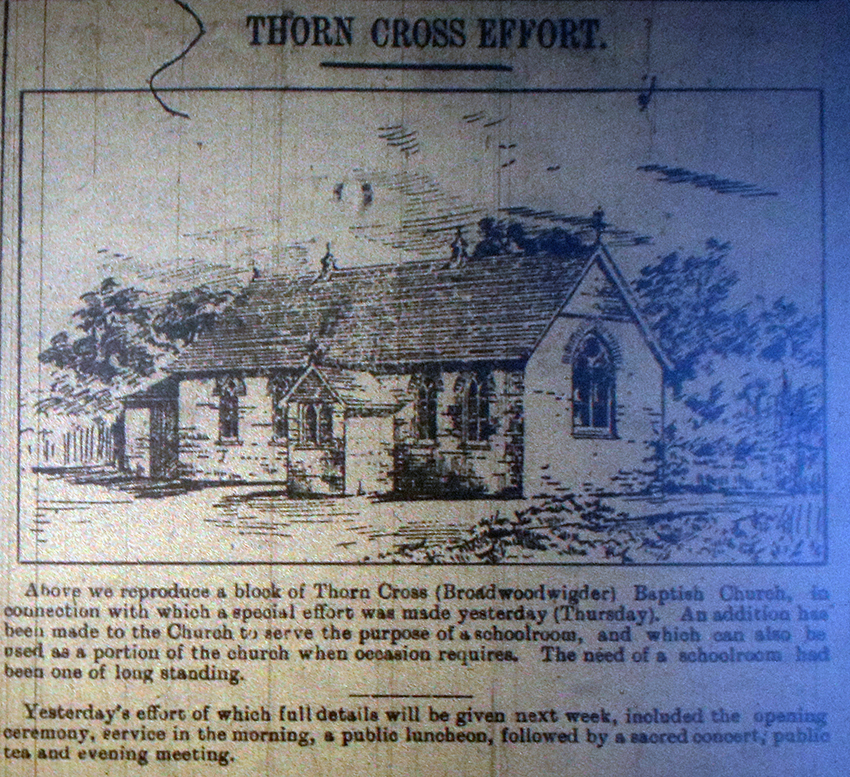
In 1987–88 excavation of the “lost” village of Hennard Mill (below) took place, this medieval settlement, originally part of the Doomsday Manor of Southweek, but only a single cottage was still standing in 1987. Excavation revealed the well-preserved remains of as many as nine buildings including two mills, with one being a Grist Mill.
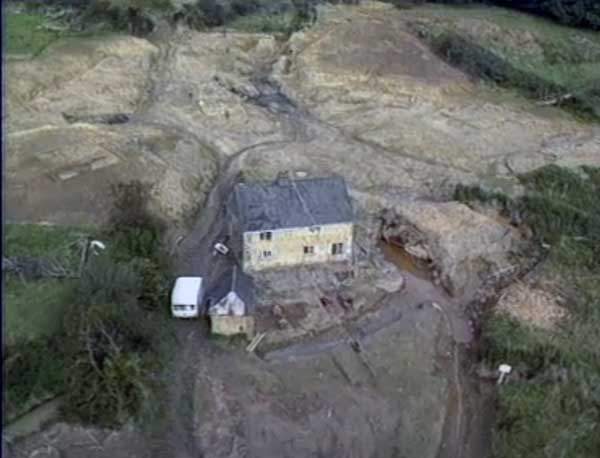
In 1857 a public House was opened called the ‘Union Inn.’ This remained in use until March 1957 when the owners, ‘City Brewery Company,’ transferred its licence to the ‘Junction Inn’ at Halwill. By this time the ‘Union Inn’ had become unprofitable. The transfer went ahead despite a valiant effort by the parishioners to keep it open, with Mr. J. Trickey providing a petition by 91 villagers asking for the licence to be kept.
White’s Devonshire Directory of 1850 for Broadwood.
Morris and Co.’s Commercial Directory and Gazetteer 1870 for Broadwood.
Those from Broadwoodwidger that served their country during World War One
* Denotes that they died or were killed during the course of the war.
James Avery

James was the eldest son of John and Emma Jane Avery being born in 1883 at Broadwood. His father was a Farm Labourer. He had enlisted with the Royal Field Artillery in the early 1900’s serving a term of five years, retiring with good conduct and an exemplary character. In 1911 he was living with his wife Annie (nee Hicks) and four year old son Francis at Tower street, Launceston and working as a Ironmongers Porter. By 1914 he was the caretaker of the Launceston Sewage works at St. Leonards. The day after the declaration of war he left to re-join his Regiment before even getting the call to colours. He served with the 23rd Battery of the R.F.A. As a Driver (possibly No. 23960). He was soon at the front being engaged in the battle of Mons, the very first battle that the B.E.F. Took part in. He was also at the battle of Ham and three other engagements, during which he was fortunate in escaping lightly, when his horse was shot under him and he fell in a ditch. He escaped with a sprained ankle and straining of the thigh muscles.
James spoke of his experiences to the Cornish and Devon Post when he returned home to convalesce on October 23rd, 1914:
Driver J. Avery, R.F.A., who was wounded in the battle of the Aisne, and has been in hospital at Plymouth about a fortnight, arrived at Launceston on Friday last. He looked remarkably well, and jocularly remarks that he has been ‘fattened’ whilst in hospital. He took part in the battle of Mons, and in that wonderful retreat to within a few miles from Paris, which is described as one of the greatest military achievements ever know.
SHELLS IN JEWELLER’S SHOP.
He left Launceston, he said, on August 5th (1914) for his headquarters, arriving there in the evening, and sleeping with 500 others in the Square. He joined his battery at Bulford, and after a few day’s training left for Southampton en route for France. They went by train as far as Arras, and then marched to Mons, where they arrived about 9:30 on Saturday evening. bout 4:30 the next morning they were in action. He had his baptism of fire in an orchard close to the town. The Gordon Highlanders came to relieve them, and their charges on the enemy, says Driver Avery, were magnificent. He had a horse shot under him at Mons, and also got hit in the thumb, the sensation, he describes, as being similar to a bee sting. The Germans did not like the bayonet, he remarked, and shrieks could be heard when the British were coming towards them. The enemy, however, were in overwhelming numbers and Driver Avery’s battery had to retire to another part of the town, close to the Middlesex and Lincoln regiments. They fought well, but suffered very heavily. Driver Avery was close to a jeweller’s shop, when shells from the German guns smashed everything and knocked the jewellery into the street. The enemy were as thick as ants, and the British retired through Ham and St. Quentins and for four days the fighting was practically continuous. The sound of the guns was terrible; thunder could not be compared with it, and several of the men had become deaf through the great noise.
THE ‘POST’ WELCOME.
Whilst having had a little rest at Cambrai, Driver Avery receieved a ‘Cornish and Devon Post,’ and “you should have seen the crowd around me” he said “at the sight of a newspaper.” That single paper was read by hundreds, both men and officers, and handled until the print was hardly readable.
FRENCH WOMEN HELP TO DIG TRENCHES
The British retired to within 15 kilometres of Paris, but during that retreat they fought well and put every obstacle in the way of the Germans. The bridge at the beautiful town of Meux was blown up, and when they got sufficiently far away from the enemy, trenches were dug, perhaps not very deep, and they were sometimes helped in this work by the French women, who did all they could for the British soldier. Driver Avery speaks very highly of these women, who would provide the Britishers with food on their march, giving them ducks, fowls, hares, in fact, anything they had got, knowing, of course, that if ‘Tommy’ did not get it, the Germans would steal it in their pursuit. These women also brought water for the horses, so eager were they to show their gratitude to our army.
NO YOUNG MEN LEFT.
Where they could, the Germans drove these people before them, compelling the British to try and attack the enemy in the rear. These actions have been most costly, but it made our boys blood boil. They were very determined to get to grips and would not give in until utterly forced to. If their feet got sore with marching, they used their putties as bandages and walked in this way. Villages were very close together, but the inhabitants consisted solely of women, children and old men. Driver Avery alluded to the terrible sights he had seen of people leaving their homes; those who could not walk being driven away in wheelbarrows. Children were often taken care of by the British soldier. Driver Avery himself carried a child for miles on his horse with him to a place of safety, and shared his food, which consisted chiefly of bully beef and biscuits, with it. At times they had no idea what day it was, or where they were, the names on the signposts for some reason being obscure. It was a beautiful country, and every bit of available land was cultivated.
SPIES MADE SHORT WORK OF.
One evening, evidently thinking they were quite safe, Driver Avery, with 400 or 500 others, were having a ‘sing-song’ as he said, and a smoke in a filed, when to their surprise, they were informed of the enemy’s presence by a shower of lyddite shell coming amongst them. “So we had to again set to work,” he remarked, “after some had been killed.” They had been plagued a good deal with German spies, who had been very daring in their exploits, but once found out “short work was made of them.” The Germans, in addition to burning villages, carried away furniture, bicycles, and anything they could lay their hands on.
A HAUL OF MOTOR CYCLES.
On one occasion a German motor lorry was seen going across the country about two miles distant. Attention was given to it by the guns, and the lorry was damaged to such an extent that it could not proceed. On inspection it was found to be full of motor bicycles, which, of course, became useful to the British. At other times, vehicles were captured loaded with furniture.
VILLAGES IN FLAMES.
The scenes witnessed in the advance towards the Aisne almost baffled description, but the French endured the hardships bravely, even when they returned ad found their homes in ruins. Villages were in flames, and to get the horses to go through, bags had to be thrown over their heads. Plundered bicycles, which the Germans had left in their retreat, were found by the roadside, and motor lorries had been driven into ditches, and damaged, and others burnt, so that they should not be used by the British. Several, however, were fitted up by the engineers, and a large number captured in this and other ways were now being used to advantage. Empty wine bottles and broken furniture were also a common sight. The latter was used by the ‘Huns’ as barricades, and passing through some places the streets had to be cleared before the horses could pass.
FIGHT IN MID-AIR.
Driver Avery said it was wonderful what amount of information the airmen would glean, the accuracy with which they could tell of the enemy’s position, and the approximate number of troops. He has seen a fight in mid-air between a Frenchman and a German, and after some fine manoeuvring the Frenchman managed to soar over his opponent and bring him to the ground with a pistol. The British officers had acted gallantly throughout, he said, and would not order their men to go where they would not go themselves. They had had torrents of rain. On the 14th September he had the opportunity of seeing the Devons going into action, and a fine lot of men they were. When in action, we seemed, says Driver Avery, those heavily in horses, the object evidently being to prevent our men from getting their guns away in case of attack.
FORTUNATE ESCAPE.
Whilst in action in the battle of the Aisne, Driver Avery was fortunate in escaping as lightly as he did. His two horses, the one he was riding and the other leading, were both killed, and he was hit in the leg by a bullet. He fell, the horses rolling on him, and he lay in this precarious position for eight hours, being unable to extricate himself. He was pinned to the ground for a whole night, lying in blood, and with the guns roaring all around him. Asked how he felt, he said he had plenty of company – both dead and wounded. When discovered by the Army Medical Corps, the heel of his boot had to be taken off in order to free him. He could not walk, and with 30 or 40 other wounded was taken to a private residence. This proved to be only a temporary resting place, for the Germans soon began shell it and he with others had to be taken across the pontoon bridge. He was conveyed to the base, and afterwards brought to England with other wounded soldiers. On landing at Southampton they were met by thousands of people, who gave them a hearty welcome. At the hospital at Plymouth they had every attendance. Gifts came from all directions and they had the luxury of cigarettes. In France the soldiers had to resort at times to tea leaves, clover buds, etc, to get a ‘whiff.’ Our men are best on getting souvenirs, and Driver Avery procured among other things a German cup, which was exhibited at the recruiting meeting at Launceston on Tuesday. Driver Avery leaves Launceston again on November 7th.
Frank Avery
Frank was another son of John and Emma Jane Avery born in 1893 at Broadwood. His father was a Farm Labourer. On leaving school Frank went to work for Mr. Thomas Ward at Fernhill, Broadwood as a Farm worker. He enlisted in the army with the possible Regimental No’s. 86550 and 1013868.
Samuel Avery
Samuel was on the 24th of August 1889 at Lifton, Devon, yet another son of John and Emma Jane Avery . His father was a Farm Labourer. He enlisted on the 8th of August 1907 with the Royal Navy (Service No. 236216) serving as a Leading seaman aboard ‘HMS Marlborough’ at the beginning of the war. He had served upon many ships during his service including the ‘Cumberland’, ‘Defiance’, and ‘Argyll’. On the 4th of September 1917 he was promoted to acting gunner aboard ‘HMS Defiance’. He was awarded the D.S.M. For conspicuous gallantry in handling his gun in several engagements. He was also awarded the French M.M. He survived the war.
William Avery
William was born on the 17th of March 1885 at Northlew, Devon and was yet another son of John and Emma Jane Avery . His father was a Farm Labourer. He joined the Royal Navy on the 17th of March 1903 (Service No. 212620). He served upon many ships during his career including ‘HMS Tiger’ during the war years by which time he had risen to an Able Seaman. He finally finished his Naval service on the 20th of March 1924.
Samuel Bradford
There is no information available other than he was with the Army reserve.
Edward John Bridgeman
Edward or John as he was known was born in 1898 to Richard and Rebecca Bridgeman at Downacary, Broadwood (St. Giles). His father was a farmer and on leaving school John worked on his fathers farm. There is no record of his military service other than an entry in the Cornish and Devon Post.
Walter Hampton Bridgeman *
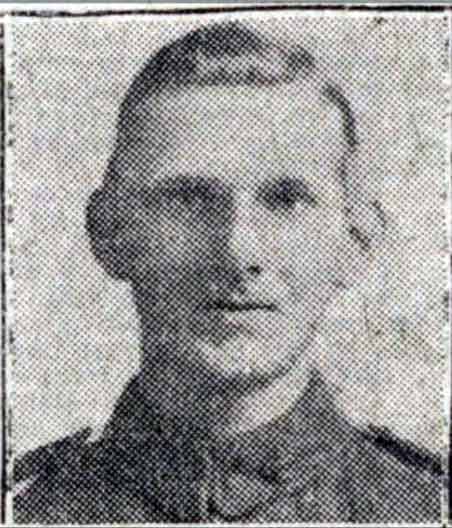
Walter was John above’s brother being born in 1899 to Richard and Rebecca Bridgeman at Downacary, Broadwood (St. Giles). His father was a farmer and on leaving school Walter worked on his fathers farm. Walter enlisted whilst underage with the Devonshire Regiment (Regimental No. 205160) serving with the 2nd Battalion. He rose to the rank of Sergeant. He was killed in action on the 27th of May 1918 in Champaign, France possibly during the Third Battle of the Aisne. There is no known grave but his name is commemorated on the Broadwoodwidger Church Roll of Honour.
The Third Battle of the Aisne (French: 3e Bataille de L’Aisne) was a battle of the German Spring Offensive during World War I that focused on capturing the Chemin des Dames Ridge before the American Expeditionary Forces arrived completely in France. It was one of a series of offensives, known as the Kaiserschlacht, launched by the Germans in the spring and summer of 1918.
Fred Burnett
Fred was born in 1891 to John and Sarah Ann Burnett at Alverdiscott, Torrington. He was the brother of Froude and Frank below. His father worked as a gamekeeper. By 1911 Fred is working as a Railway Clerk. There is no information on his military record other than he was serving with the Army.
Froude Burnett
Froude was born in 1896 to John and Sarah Ann Burnett at Ashwater. His father worked as a gamekeeper. On leaving school Froude worked as a Morning Postman. He enlisted with the Duke of Cornwall’s Light Infantry (Regimental No. 3/4917) rising to 2nd Lieutenant. He was wounded in 1916. (He had two brothers also serving with Frank, below, being killed in December 1914). Froude was awarded the Military Medal in February 1918.
Frank Burnett *
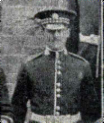
Frank was Froude’s elder brother being born in 1892 to John and Sarah Ann Burnett at Ashwater. His father worked as a gamekeeper. In 1911 he is living with his brother-in-law John Newbery at Ashwater and working as a Timber Sawyer. He enlisted at Devonport joining the Scots Guards (Regimental No. 8578) on March 19th, 1913 serving with the Expeditionary force and taking part in the First Battle of Ypres. In October 1914 he wrote home to his sister, Mrs Newbery at Ashwater and he stated how lucky he felt coming through seven days of heavy fighting alive. “My company (‘C’ company) lost all its officers except one second lieutenant.”
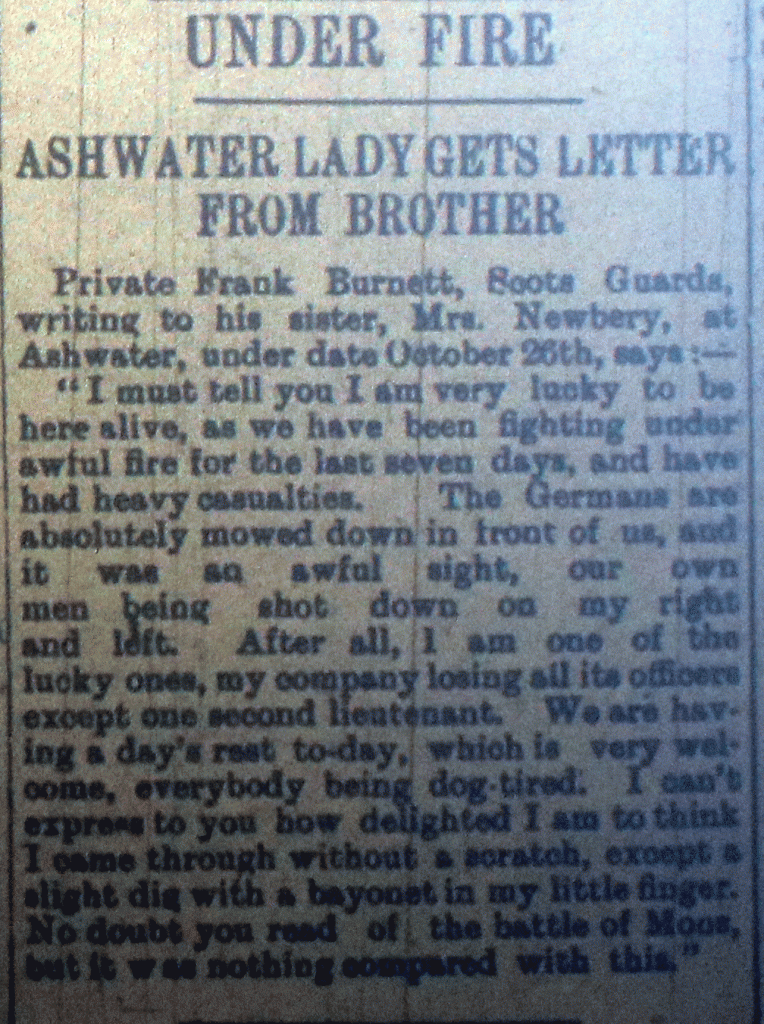
With such heavy losses in his company, it was no surprise to learn that Frank soon rose to the rank of Lance Corporal and was whilst serving with the ‘C’ Company of the 2nd Battalion when he was killed in action during an attack on the German trenches on the Fromelles-Sailly Road on December 18th, 1914. His body was never identified but his name is commemorated on the Ploegsteert Memorial, Panel 1 and on the Broadwoodwidger Church Roll of Honour.
18.12.14 Report by Captain G.H. LODER (who was later to lead the Christmas Truce of 1914):
On Friday Dec 18th I was ordered by Captain PAYNTER to lead an attack on the German trenches with 2 Coys of the 2nd Bn Scots Guards. The RIGHT of the attack to rest on the FROMELLES – SAILLY Road, the LEFT of our line approximately 400 yards E of this point where the border Regt joined our lines in No 2 subsection.
This Regt was to carry on from this point. I was ordered to meet Captain ASKEW and arrange details with him at 3:45pm. The attack was timed for 6pm. It was arranged that at 6pm the men should be posted over the parapet and to crawl out under the wire fence and lie down. When this was done I was to blow my whistle and the line was then to move forward together and walk as far as they could until the Germans opened fire and then rush the front line trenches. Having reached the trench I was to try and hold it, if occupied, and if unoccupied to push on to the second line. The men carried spades and sandbags. F Coy Captain Sir F FITZWYGRAM, LF Captain H TAYLOR. At about three minutes to 6pm the men were hoisted over the parapet and lay down. I blew my whistle as loud as I could but, owing to the noise of our gun fire, it appears that it was not generally heard. F coy being on the RIGHT and LF on the LEFT we began to move forward. After advancing about 60 yards I could see that in several places the line was not being maintained; some men moving forward faster than others. I could see this by the flash from the guns. I collected the men nearest to me and I found myself practically on the parapet before the Germans opened fire.
There was no wire entanglement at this point. We bayoneted and killed all the Germans we could see in the trench and then jumped down into it. There was a certain amount of shouting and confusion. I could not see far to my RIGHT or LEFT or tell what was happening on either flank. The position of the trench in which I found myself was not traversed for a distance of at least 25 yards. I ordered the men to make firing positions in the rear face of the trench. This was not easily done owing to the depth of the trench. I also told off some men to watch the flanks and, if the enemy appeared, to make traverses. I remained in the trench some time, about one hour, and then thought I had better try and see what had happened at other places in the line. I got out of the trench, which I left in charge of Lieut SAUMAREZ, and told him to hang on. I found it impossible to get any information but could see a good many dead bodies lying close to the German parapet.
I decided to come back to report to Captain PAYNTER and explain what the situation was and suggest that, if the trench was to be held, reinforcements would have to be sent up. This he reported to the Brigadier as it then became apparent that the attack of the border Regt had failed and also that 2 Coys RIGHT had only succeeded in getting into the trench in a few places he was ordered not to send forward the remaining two Coys which were in reserve. I was then ordered to organise a digging party to sap to the German trench. This was attempted but, owing to a continuous German fire, it soon became clear that the distance, 180 yards, was too much. About 3am Lieut WARNER and a party of 10 men were led forward by Corporal JONES to the section of the German trench which was still in tact. He reached it alright and found Lieut SAUMAREZ wounded [in the hand and that a stretcher was sent out and, with great difficulty, Lieut SAUMAREZ was removed]. Lieut WARNER was ordered to withdraw. Just before dawn he accomplished this without loss. Shortly after the attack was launched Lieut OTTLEY and a party from G Coy were sent up to reinforce Lieut HANBURY TRACY. While at the head of his men he was mortally wounded before reaching the German trench and the rest of the party don’t appear to have been able to reach the trench. Corporal MITCHELL, with great courage, brought back Lieut OTTLEY (Lieut OTTLEY was awarded a DSO).
During this attack the Germans don’t appear to have used any bombs or hand grenades. The crossfire from well placed German Machine guns played a big part and this accounts for our very heavy casualties amounting to nearly 50%, about 180 men being killed or wounded. Among the officers:
Killed: Captain H TAYLOR, LF Coy; Lieut Hon HANBURY TRACY F Coy
Missing: Lieut NUGENT LF Coy (believed to have been killed)
Wounded: Lieut SAUMAREZ LF Coy; Captain Sir F FITZWYGRAM F Coy
Died of wounds: 2/Lieut OTTLEY G Coy
Captain LODER was the only officer who returned unwounded. Pte CLARKSON has an Iron Cross which he found on a dead German officer.
It’s only anecdotal but in a BBC programme on the Christmas Truce it said that there was a mass burial on that day. This would suggest (no more than that) that those burials were of men, including Frank from that same raid.
Edward John Coombe
Edward was born on the 8th of December 1892 to James and Sarah Coombe in Launceston. His father passed away and Sarah remarried. His Step-father William Henry was a Road man and in 1911 the family were living at Kellacott, Broadwood. On leaving school Edward worked as a Journeyman Tailor. He joined the Royal Navy (Service No. L4328) in December 1912. H e served upon just the one ship ‘HMS Bellerophon’ which took part at The ‘Battle of Jutland’ where she fired 62 12 inch rounds receiving no damage in return. Edward was demobbed in March of 1919. He died in 1925 at Launceston.
Frederick Cole
Fred was born in 1895 to Samuel and Eva Cole at Bratton Clovelly. His father was a Farm Waggoner. On leaving school Fred worked as a Carter on a farm. He enlisted with the Devonshire Regiment serving with the 6th Battalion as a lance corporal.
George Basil Cowell *
George was born in 1891 to Arthur and Emily Cowell at Dunmow, Essex. He enlisted as a Aircraftman 2nd Class of the 6th Balloon Section the Royal Air Force (service no. 291526). He died on February 22nd, 1919 in France aged 28. His name is commemorated on a plaque in the church porch:
OF YOUR CHARITY PRAY FOR THE SOUL OF GEORGE BASIL COWELL WHO SERVED IN THE WAR AND DIED IN FRANCE FEBY 22ND 1919 FOR FIVE YEARS LAY READER AND MASTER OF THE CATECHISM IN THE PARISH “JESU MERCY” (EXAC TLINE SPACING UNKNOWN)
He is also commemorated on the Broadwoodwidger Church Roll of Honour as well as the Little Bardfield War Memorial.
Albert Ernest Down
Albert was born in 1892 to Eber and Susannah Down at Hampool, Bickleigh. His father was a Rabbit trapper with Albert taking up this trade on leaving school. In 1911 the family were living at Ivyhouse, Broadwood. There is no military record for him.
F. Down
There is little information available other than he joined the Royal Navy.
W. Down
There is little information available other than he joined the Royal Navy.
Fred Furse *
Fred was born in 1896 to Mr and Mrs T. Furse at Werrington. The family were living at Thorndon, Broadwood in 1916. He enlisted with the Royal Dublin Fusiliers (Regimental No. 13661) . He served through the Gallipoli campaign serving with the 1st Battalion. Of the 1012 men of the 1st Battalion Dublin Fusiliers who had gone ashore in April 1915, only 11 men, including Fred survived the killing, mutilation and disease of that terrible few months. They left on January 1st, 1916 arriving in Egypt seven days later.
On March 13th, 1916 the 1st Battalion who had by then been brought back up to full Battalion strength, sailed from Port Said to Marseilles for service in France. It was with this strength that they attacked Hawthorn Ridge at Beaumont Hamel on July 1st, 1916 during the first day of the Battle of the Somme. At 7.20am the large mine at Hawthorn Ridge in front of the 1st Battalion was exploded. The main attack did not start until 7.30am which gave the German defenders time to occupy the mine crater. The 2nd Royal Fusiliers and the 2nd Lancashire Fusiliers went over the top in the first wave. The ‘Dubs’ were to follow and assault the German second-line system. The first wave was cut down by machine gunfire and progress through the trenches to the front line was hampered. Two companies went over the top but the barbed wire was only cut at intervals of about 40 yards, upon which the German machine guns were trained. Very few got beyond the British wire and the attack was halted at noon. 22 were killed including 4 officers with a further 65 missing. Fred although again survived this attack.
The months of July and August along the Somme valley were days of attack and counter attack, advance and retreat, success followed by failure, i.e. stalemate with many more being killed including Fred, who was killed in action on the 26th of August 1916. His body was never identified but he is commemorated on the Kipling Memorial in Valley Cottages Cemetery, Zillbeke, Mem. E. 2. He is also commemorated on the Broadwoodwidger Church Roll of Honour.
George Hocking
George was born in 1882 to William and Eliza Hocking Broadwood. His father was a Wood ranger. In 1901 George was working for Mrs. Charity Worden at West Week Barton, Broadwood as a Farm Horseman. He enlisted with the Royal Navy (Service No. 298787) on the 7th of October 1907. He served aboard many ships including during the war ‘HMS Diana’, ‘HMS Challenger’, and finally ‘HMS Leopard’ of the ‘HMS Wallington’ which was the Auxilliary Patrol base at Grimsby. He was demobbed on the 18th of October 1924.
S. Lake
There is little information available other than he joined Kitchener’s Army.
George Lyle
There is little information available other than he joined the Territorials.
John Mathews *
Possibly Henry John Joseph born in 1875 to John and Grace Mathews. This John’s wife’s name was (Edith) Mary. The navy has compiled lists of WW1 casualties who did not survive the last journey of HMS India. An armed merchantman, India was on guard duty patrolling the coast of Norway in 1915, when torpedos were fired at her from a German submarine causing the ship to split in two. There were survivors from this incident and some men were rescued from the sea, taken to Norway and interned for the duration of the war, but John Mathews (the name he used) was on the drowned list. The names of many men on this list are not followed by a military number (though John’s has an indication that his number places him in Devon at the time of enlistment) through which John could have been traced but on the list supplied by www.devonhonour.org, On this list, John is described as being a private who drowned. At the time of his death, John was fulfilling the function of Chief Steward and no naval rank is given for him.
Frederick Samuel Mayne
Frederick was born in 1888 to William and Mary Mayne at St. Giles on the Heath. His father was an Agricultural Labourer. In 1911 he is living with his wife Elizabeth (nee Parsons) and their one year old son William T. in Broadwood village. There is no information on his military record although he could have served with the Machine Gun Corps.
Leonard Melsome *
Leonard was born in 1896 to William and Bertha Melsome in Hendon, Middlesex. His father was a cab driver.
Leonard enlisted with the Gloucestershire Regiment (Regimental No. 13651) as a Private serving with the 8th Service Battalion. He died of his wounds sustained during the Battle of the Somme, on the 7th of July 1916. He was interred at the Heilly Station Cemetery, Mericourt-L’Abbe, Cemetery/memorial reference:Plot 1, Row F, Grave 15. He is also commemorated on the Broadwoodwidger Church Roll of Honour. His mother, Bertha Rundle, now remarried, had moved to Thorn Moor, Broadwood at the time of his death.
Roy Algernon Mills
Roy was born in 1897 to Robert Edward and Sarah Jane Mills at Devonport, Plymouth. His father was the Schoolmaster at Ivyhouse School, Broadwood. On leaving school, Roy took up an apprenticeship in Carpentry. He enlisted with the Devonshire Regiment as a Lance Corporal with the 6th Battalion rising to the rank of sergeant. After the war he joined the Royal Navy on the 1st of July 1919 as a joiner before being then transferred to the R.A.F. He married Ethel May Henley of Torquay on the 7th of April 1920 and they set up home in Wallen street, Torquay. He was discharged from the R.A.F. on the 8th of November 1922.
Richard Miller
There is little information available other than he joined the Devonshire Regiment 6th Battalion.
Charles Mitchell
There is little information available other than he joined the Devonshire Regiment 6th Battalion.
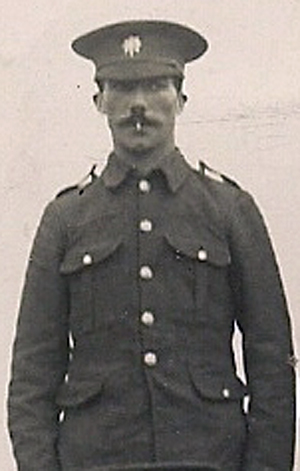
Sid, as he was known, was born on February 15th, 1889 to John and Georgina Moon at Baytree Hill, Liskeard. His father was a gardener. He was a Waggoner and Labourer and in 1911 was living with his brother at Ashmill, Broadwood. He joined the Devonshire Regiment as a Private (Regimental No. 1320) first with the 6th Battalion and then with the 1/4th Battalion. With his Battalion he left Plymouth for India aboard R.M.S. Empress of Britain on January 5th, 1917, arriving at Bombay on Marth 5th, 1917. Here he was based at Gough Barracks, Tremalgherry, Dechan. Surviving the war, Sid returned home to live and work in the Germansweek area. He married Lillian Mary Cole. Sid passed away on August 8th, 1943. More
Wilfred Nelder *
Wilfred was born in 1893 to William and Sarah Ann Nelder at Plympton. His father was a Publican. In 1911 his father was the publican for the Inn at Blisland. He enlisted (Kitchener’s army) with Royal Devonshire Yeomanry (Regimental No. 2496) but was transferred to the Devonshire Regiment (Regimental No. 345219) He was a Sergeant. Whilst serving with the 16th (Royal Devon and R. North Devon Yeomanry) Battalion, he was killed in action on September 2nd, 1918 probably during the Second Battle Of Bapaume. He was interred at the Peronne Communal Cemetery Extension, Cemetery/memorial reference: III. D. 28. He is also commemorated on the Broadwoodwidger Church Roll of Honour.
The Second Battle of Bapaume was a battle of the First World War that took place at Bapaume in France, from August 21st, 1918 to September 3rd, 1918. It was a continuation of the Battle of Albert and is also referred to as the second phase of that battle. The British and Dominion attack was part of what was later known as the Allies’ Hundred Days Offensive.
The Second Battle of Bapaume was carried out over a period of two weeks and involved the divisions of IV Corps; the British 5th, 37th, 42nd, and the 63rd Divisions along with the New Zealand Division. On August 29th, elements of the New Zealand Division, after heavy fighting in the days prior, occupied Bapaume as the defending Germans withdrew. It then pushed onto the Bancourt Ridge, to the east of Bapaume.
John Oag
John was born on the 10th of February 1886 to James and Mary Oag at Broadwood. His father was a farmer and a JP living at Thorndon House, Greenacombe Moor, Broadwood. His brother was Mr. A. Y. Oag who was the manager of Fox, Fowler and Co’s. Bank in Launceston. He served for three years with the 1st Middlesex Engineers and qualified as a Draughtsman. He emigrated to Canada in 1911 but on the outbreak of war enlisted with the Canadian Engineers (railway) at Montreal serving with the 4th Field Company. Back in this country, John married Dorothy Stinchcombe of Okehampton in January 1917 setting up home at Thrumater, Okehampton. He was a Sergeant at the time and in November 1916 had been mentioned in dispatches for bravery on the field.
Alfred Palmer
Alfred was born in 1898 to John and Emma Jane Palmer in Broadwood. His father who had been a Farm Labourer died in 1899. He joined the Devonshire Regiment 6th Battalion but after 18 months training he was discharged as being medically unfit for service and then became the agent for the ‘Western Times’ newspaper for the Broadwood district living with his mother at Norton Gate, Broadwood.
John Thomas Palmer *
John is another son of John and Emma Jane Palmer and was born in 1891 at Dubbs Cottage, Broadwood. On leaving school John worked as a Farm Labourer. He enlisted with the Devonshire Regiment (Regimental No. 3961) serving with the 6th Battalion. He died whilst serving in India on April 12th, 1916 (presumed through illness). He was original interred in the Bombay (Sewri) Cemetery but was exhumed and re-interred at the Kirkee War Cemetery, Poona, India, Plot 10, Row D, Grave 10. He is commemorated on the Broadwoodwidger Church Roll of Honour.
Richard Palmer
Richard is another son of John and Emma Jane Palmer and was born in 1893 at Morton Cottage, Broadwood. In 1911 he was working for Mr. John Veale of Middlecott farm, Virginstow as a Farm Waggoner. There is little information available other than he joined the Devonshire Regiment 6th Battalion. In 1922 he married Dorice Bassett at Launceston.
William Henry Palmer
William is another son of John and Emma Jane Palmer and was born in 1896 Broadwood. On leaving school William went to work as a Domestic for Mrs’ Nosworthy of Grinnacombe, Broadwood. William joined the Royal Navy (Service No. K22288) on the 8th of August 1914 as a Stoker and served aboard ‘HMS Erin’ during the war. But he continued in the service until 1929 with his final ship being the ‘Emperor of India’.
John Parsons
John was born in 1895 to John and Elizabeth Parsons at Launceston. His father was a Gardener and the family were living at Witheridge Lodge, Broadwood in 1911. On leaving followed into his father profession as a gardener. John initially enlisted with the Devonshire Regiment (Regimental No. 1535) but was transferred to the Duke of Cornwall’s Light Infantry (Regimental No. 235026). He survived the war and lived until 1974.
Ernest Phillifant
Ernest was born in 1886 to John and Ellen Phillifant at Lifton and was one of nine children. His father was a Roof Thatcher. Ernest enlisted at the beginning of the war initially with the Devonshire Regiment (Regimental No. 7532) but was later transferred to the Machine Gun Corps (Regimental No. 19143). He rose to the rank of Sergeant. He died in 1923.
Samuel Thomas Sleeman *
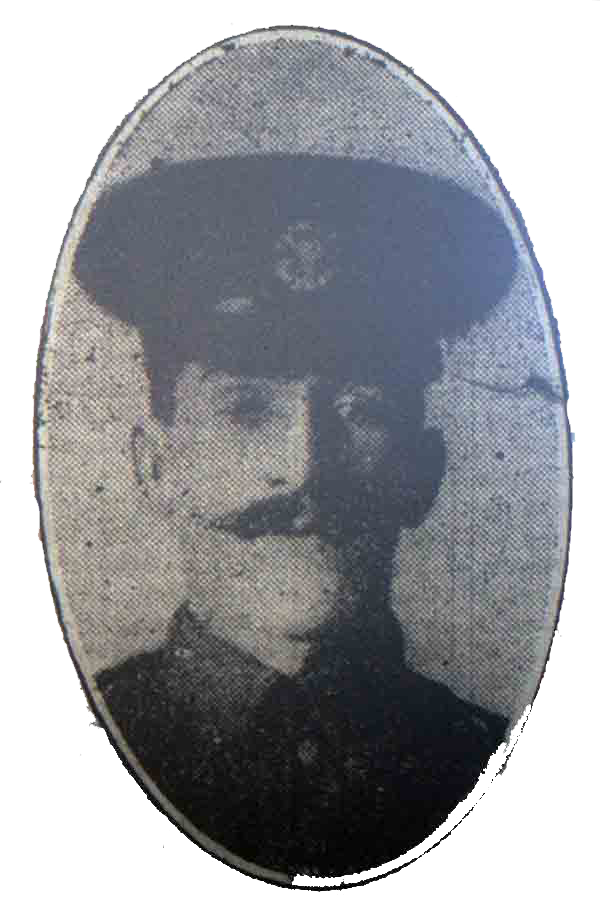
Samuel was born in 1882 at Coombe Brye Farm, Broadwoodwidger to Samuel and Mary Sleeman. His Father was a Farmer. On leaving school, Samuel worked at home on his Father’s Farm as a Carter. His Mum later moved to Wooda, Launceston. He initially enlisted with the Devonshire Regiment (Regimental No. 7701) in 1904 but later transferred to Somerset Light Infantry as a Corporal (Regimental No. 8064) serving with the 8th Battalion ‘C’ company. In 1916 at Hackney, London he married Gertrude Stayton but they never had any Children. Their marital home was at 376, Finchley Road, Hampstead, London.
He was killed in action just after the Somerset’s had been involved in the 2nd Battle of the Scarpe on the 28th of April 1917. His body was never identified but he is commemorated at the Faubourg-d’Amiens Cemetery, Arras, Departement du Pas-de-Calais, Nord-Pas-de-Calais, France, Plot: Bay 4. He is also commemorated on the Launceston War Memorial and on the Broadwoodwidger Church Roll of Honour.
The Battle of Arras (also known as the Second Battle of Arras) was a British offensive on the Western Front during World War I. From April 6th to May 16th 1917, British troops attacked German defences near the French city of Arras on the Western Front. The British achieved the longest advance since trench warfare had begun, surpassing the record set by the French Sixth Army on July 1st 1916. The British advance slowed in the next few days and the German defence recovered. The battle became a costly stalemate for both sides and by the end of the battle, the British Third and First Armies had suffered about 160,000 and the German 6th Army about 125,000 casualties.
Harold Squire
Harold was born in 1883 to Thomas and Elizabeth Squire in Broadwood Village. His father was the local Groucer. On leaving school Harold became an Outfitters assistant working for Mrs. Spence of High street, Launceston in 1901. In 1911 he is boarding with Mr. Stanley Tucker of Broad street, Launceston. There is no qualified record for his military service but he did survive the war and was married in 1922 to Margaret Balkwell.
William Titball
William was born in 1886 to William and Elizabeth Titball at Heale, St. Giles on the Heath. His father was an Agricultural Labourer. On leaving school William went to work for Mr. Albert Stenlake at Waterloo farm, North Petherwin as a Cattleboy. By 1911 he was married and living with his wife Beatrice at Carey Cottage, St. Giles on the Heath with their son Reginald William and daughter Beatrice Mary. William was working as a Cowman. The only record of his military service is from the Cornish and Devon Post which stated that he had joined the Territorials.
William James Tubb * (with thanks to Alan Tubb)
William was born on July 19th, 1895 at Davidstow to John Henry and Mary Tubb. William enlisted in the Devonshire Regiment as a Private (Regimental No. 5036). He served with the 1st/6th Battalion. He was killed in action on March 8th, 1916 aged 20. His body was never identified but he is commemorated on the Basra Memorial, Iraq, Panel 11. He is also commemorated on the Ashwater War Memorial. At the time of his death his parents were living at No. 4, Bridge Park, Ashwater.
At the end of 1915 the 1/6th were sent to Mesopotamia and they arrived at Basra on January 3rd 1916. Marching 300 miles up country through swamps, marshes and deserts, they suffered sickness and attacks from local Arabs before reaching Orah. From here, in early March, they launched an attempt to relieve the besieged garrison at Kut el Amara. Tantalisingly, they were within sight of Kut when a bungled artillery bombardment warned the Turks of their advance and heavy shell and machine gun fire forced them to retreat. The 1/6th lost 201 casualties including William and were congratulated on their bravery.
Harry Ward
There is little information available other than he joined the Devonshire Regiment 6th Battalion.
Percy White
There is little information available other than he was part of the Kitchener’s army.
Broadwoodwidger’s Fallen from World War Two.
Charles James Vernon Shopland
Charles or Vic as he was known, was born on May 6th 1912 at Road Ford, Broadwood to Samuel and Sarah Shopland. In 1940 he married Winnifred Rich at Okehampton. He enlisted with the Royal Army Service Corps as a Driver at Launceston (Regimental No. 220176). While on active service in the Middle East on May 11th 1942, he was drowned (with others) when his boat capsized whilst crossing the Nile. He was buried with military honours in the British Cemetery at Wadi Halfa, Sudan on May 14th 1942.
* Denotes that they died or were killed during the course of the war.
Kelly’s 1902 entry for Broadwoodwidger
The area is 10,630 acres of land and 25 of water; rateable value, £5,519; the population in 1901 is 713. By Local Government Board Order 15,034, which came into operation March 24, 1884, a detached part of Lifton, known as Westweek, in Tavistock union, and a part of Bratton Clovelly, was amalgamated with this parish.
Sexton, William Davey. Post Office. Thomas Squire, sub-postmaster. Letters through Lifton H.S.O. arrive 7.50 a.m.; dispatched 4.45 p.m. week days only. Postal orders are issued here, but not paid. Lifton is the nearest money order & telegraph office, 4 miles distant The north part of the parish is served from Beaworthy
via Ashwater.
BROADWOOD WIDGER RURAL DISTRICT COUNCIL.
Meets at Council Room, Union Workhouse, Launceston, on alternate Saturdays at 1 p.m. The places in the district are Broadwood Widger, Northcott Hamlet, North Petherwin, St. Giles-in-the-Heath, Virginstowe & Werrington.
Chairman, A. Macbeth
Clerk, George Graham White, solicitor, Launceston
Treasurer, Edward Pethybridge, banker, Launceston
Medical Officer of Health, Charles Gordon Gibson M.B. & C.M. Dunheved road, Launceston
Surveyor, F. Crocker, Druxton, Werrington
Sanitary Inspector, James Frayn, Pipers Pool, Egloskerry
Schools.
A School Board of 5 members was formed July 6, 1874, for the united district of Broadwood Widger & Virginstowe ; John Thomas Veale, Middlecott, Virginstowe,
clerk Board, Ivy House, built in 1880, for 90 children; average attendance, 61 ; William Hicks Hill, master Board, Thorncross, built in 1880, residence for master
added in 1893, for 80 children; average attendance, 43 ; Philip Williams, master National (infants), built in 1883, for 70 children; average attendance, 13 ; Miss Mary Walters, mistress Railway Station, Tower Hill, London & South Western railway, Frederick Henry Brazier, station master.
(Marked thus * receive letters through Ashwater, Beaworthy H.S.O.)
Blackwood-Price Rev. Townley George Loarn M.A. Vicarage
*Oag James J.P. Thorndon
Macbeth Alexander J.P. Fernhill
Perkin John Albert Rnndle, Tower hill
Spry Tredenham Hugh J.P. Witherdon
(letters via Lew Down R.S.O)
COMMERCIAL.
Andrews Thomas, farmer, Lowermoor
Andrews Thomas, miller (water),Moor
Andrews Thomas (Mrs.), farmer,West Kitchem
Bailey John, farmer, East Bainbury
Bailey & Smale- (William), farmers, Nedwood
Balkwell Isaac, farmer, Kellacott
Banbury Richard, farmer, Eastlake
Bassett Thomas, farmer, Coombs head
Bickle John, farmer. Camp
Bridgeman Richd. farmer, Downacarry
Brimacombe Geo. farmer, Downtown
Butler James, farmer, Rexton
Colwill Joseph, farmer, Emsworthy
Davey John, carpenter, Thornmoor
Dennis Albert, farmer, Buddie
Dennis Edwin, farmer, Grinnicombe
Down Bros, farmers, Frankaborough
Down James, blacksmith, Town
Fry John, miller (water), Combe
Fry Samuel, blacksmith, Ash mill
Gilbert Francis, farmer, Coombe park
Hamblv John, farmer, Westweek
Hicks John, farmer, Beckett
Hicks William, carpenter
Hill John, mason, Grinnicombe
Hole William, farmer, Kellacott
Jackman Rebecca(Mrs.),frmr, Shallafrd
Jasper Richard, farmer, Shop
Kough Bernard H. farm bailiff to T. H. Spry, esq. Moor
Littlejohn Charles, tailor, Grinnicombe moor
Littlejohn William, tailor, Bolford lane
Lobb John, farmer, Westweek
Macbeth Alexander, farmer & landowner, Fernhill
Martin Frederick, farmer, Kellacott
Martin James, farmer, Little Rexon
Martin Richard, farmer, Willtown
Martin Richard, jun. farmer, Rexton
Martin William, farmer, Combe
Matthews John A. shopkeeper & mason, Rexton cross
Murley Thomas, farmer, Rexon
Nerswonthy Mary (Mrs.), farmer, Middle Grinnicombe
*Oag James, farmer & landowner, Thorndon
Palmer Thomas, farmer, Lugworthy
Palmer Wm. frmr. Lower Grinnicombe
Penhale John, farmer & landowner, Norton
Perkin John Albert R. farmer & landowner, Tower hill
Perkin Samuel, farmer, Venn
Perkin William, farmer,Frankaborough
Pethick Charles, farmer, Kellacott
Rich Elizabeth (Miss), farmer, Rexton
Rich James, farmer, Kellacott
Rich Jethro, farmer, Cross
Rich William, farmer, Town
Rickard Edward, farmer, Town
Rockey George, farmer, Winslade
Rowland Francis, farmer, Higher Combshead
Shopland John, farmer, Treydown
Shopland Samuel, farmer, Roadford
Sillifant Isaac, farmer, Kitcham
Sillifant Samuel, farmer,West Banbury
Smale Edwin, farmer, Thorne
Squire Elizh. (Miss),Hare & Hounds P.H
Squire Thomas, builder, shopkeeper & farmer, Post office
Symons John, farmer, Westweek
Ward Thomas, farmer, Upcott Barton
Werren Daniel, farmer, North Thorn
Withecombe Lewis, farmer, Hole
Worden Charity (Mrs.), farmer, Westweek
Visits: 710


